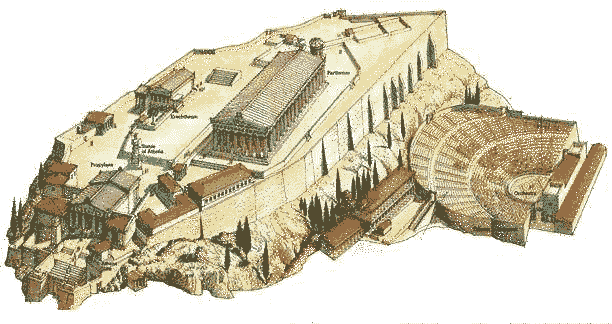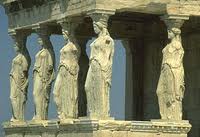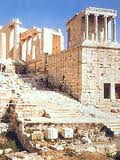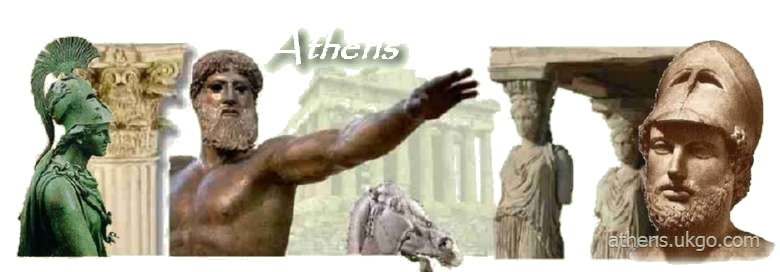The Acropolis of Athens.

Acropolis of Athens, Set in a site covering 30,000 sq.m., the Acropolis of Athens is a perfect example of how ancient architecture was adapted to a natural site to form what has become a model worldwide and down the ages. It was the ancient city’s most important religious centre and its monuments, (the Parthenon, the Erechtheion, the Propylaea -the monumental entrance to the Acropolis- and the small Temple of Athena Nike) have become an important symbol of ancient Greece’s bequest to Europe and the world.The first signs of occupation on the ‘sacred rock’ of the Acropolis date back to the Neolithic period (2nd millennium BC). In Mycenaean times (1200-1100BC) it was the seat of the king, whose palace stood roughly where the Erechtheion was built many centuries later. After the 11th century BC until the end of Antiquity, it was home to the cult of Athena, patron goddess of the city that took her name. There, Athena was worshipped at majestic temples, brilliant buildings and a vast number of votive monuments. The most renowned were built in the second half of the 5th century BC, when Athens took a lead among the ancient world’s city states, following important victories against the Persians and the establishment of Democracy. In the golden age that followed, thought and art flourished, and an exceptional group of artists made the ambitious plans of Athenian statesman Pericles reality, under the guidance of the sculptor Pheidias. The most important monuments were built during that time: the Parthenon, built by Ictinos (447-432BC), the Erechtheion with its shrines to Athena Polias and Poseidon-Erechtheus and the porch adorned with the famous Caryatids hand-maidens (421-406BC), the Propylaea - the monumental entrance to the Acropolis designed by Mnesicles (437-431BC) - and the small temple of Athena Nike (421-407BC).
The buildings
The Parthenon
Parthenon E6, MAcropolis, tel. 210 3214172. Built
between 447-437BC, during the ‘Golden Age’ of Athens
under Pericles, the Parthenon is a world famous sight.
Its design harmoniously combines the Doric and Ionic
orders, and its architectural and structural details and
the precision in the carving of the marble are a testament
to the expertise in the artisans that created it. Further,
the décor of the Parthenon and its surrounding monuments
had a profound and lasting influence on Western
art (especially sculpture and portraiture), as it depicted
the human form in an individualised manner for the first
time. These artistic innovations fuelled developments
that influenced the art of Hellenistic and Roman times,
as well as the Renaissance, Baroque, Romanticism and
Neoclassicism.
 The Erechtheum
The Erechtheum
This Temple is located on the most sacred part of the whole sacred hill. That side of the Acropolis was indeed the sanctuary were all the cults and ceremonies of Poseidon and Athena were taking place. It took its name after Poseidon killed Erechtonius, a mythical king who had the body of a snake. The temple was a part of Pericles project and is located on the northern side of the Parthenon. It was started late, in 421 BC, due to the Peloponnesian wars and ended in 406 BC.
It is an amazing example of the Ionic architecture, composed by three different dimensions basic parts which are the main temple, the northern and the southern porches. The two parts of the main temple are respectively dedicated to Athena and Poseidon. The northern porch of six columns leads to the Temenos of Pandrossos, the place where the sacred gift of Athena to the city, the olive tree, grew.
The northern porch of the temple is the most famous, since it is the one with the Caryatids, the six women replacing the columns that support the marble roof. The Caryatids were sculpted after some beautiful young models that were women from Karyes, a village of Lakonia.
 The Temple of Athena Nike
The Temple of Athena Nike
This little temple was built between 427-424 BC from a design of the architect Kallikrates. It is perched on a platform on the south-west edge of the Acropolis, and is also closed to visitors. It is an almost square building of Ionic architecture with four Ionic columns at each ends. Its frieze is adorned by a wonderful scene depicting the conference of gods and other mythological scenes on the east and south sides, and battles scenes on the other sides. The majority of the frieze has been destroyed, while some parts, like the beautiful representation of Athena Nike (Victory) fastening her sandal, are exposed in the Acropolis museum.
The Temple of Athena Nike was the shelter of an amazing statue of the goddess Athena holding a pomegranate, the symbol of fertility, in her right hand and a helmet, the symbol of war, in her left hand. The temple has been destroyed twice: once after the Turks dismantled it in 1686 and once after 1936, when the platform crumbled. It has been therefore rebuilt two times as well.
 The Propylaea
The Propylaea
The Propylaia is on the same line as the Parthenon, and is the monumental gateway to the Acropolis. Built from a design by Mnesicles, it is composed by a central hall and two lateral wings. The sections of the temple used to be the only possible way to enter the Acropolis. The northern wing was decorated with painted panels and was used as a picture gallery (the "Pinakotheke"). The south wing was the antechamber to the Temple of Athena Nike and the ceiling of the Propylaea’s central hall was painted with gold and colourful decoration. The northern wing was decorated with painted panels and was used as a picture gallery The building was build during 437-432 BC, badly damaged in the 17th century from an explosion. Its restoration started in 1909 and is still going on today.
The Panathenaic Way
The Panathenaic Way was the route taken by the Panathenaic procession during the festival of Panathenaia. This was the most important event of ancient Athens and was dedicated to the goddess Athena, and consisted in dances, athletic, dramatic and musical contests. The route was cutting through the middle of the Acropolis, beginning from the Keramikos and ending at the Erechteion.
The procession was the highlight of the festival, as it took place on its last day. It was composed of men carrying animals for sacrifices to the goddess, of maidens carrying drinking vessels (call rhytons), musicians and girls holding the sacred shawl called "peplo". The procession came to an end when the girls placed the peplo on the statue of Athena Polias, inside the Erechteion.
The statue of Athena Promachos
On the Acropolis one can see the remains of some important statues which used to form a path. One of them, 15m from the Propylaea, is where used to stand the gigantic statue of Athena Promachos (champion). This 9m high statue was a symbol of the victory and the strength of the Athenians against the Persians. This symbolism is the reason why its sculptor, the famous Pheidias, represented the goddess holding a shield in her left hand and a spear in her right one. The statue was taken to Constantinople by the Emperor Theodosius in 426 AD. It was destroyed in 1204 by the inhabitants of the city who blamed the statue for a crusader invasion they suffered.
The southwest Slope of Athens Acropolis
This area of the Acropolis played is the area where all public buildings were built. It was the part of the hill where all the major artistic, spiritual and religious activities of the city took place, hence its importance to the ancient Athens. Here are the most important monuments standing on this area:
 The Theatre of Dionysos
The Theatre of Dionysos
The remaining ruins of the 5th-century theatre built in stone and marble by Lycourgos indicates the greatness of the site: the auditorium had 17 000 seats of which only 20 survived. The Greek Archaeological Society started excavations around Dionysos' sanctuary and brought to light the theatre of Dionysos in 1838. The decorative relief at the rear of the stage is from the 2nd century BC and depicts Dionysos life and myths. Unfortunately most of the figures are headless.
During the golden age of Pericles, when Athens was at its peak, one of the major events of the year was the annual Festival of the Great Dionysia, introduced in the 6th-century AD by the tyrant Peiseistratos. It was a very interesting and cultural event. Politicians and rich people would sponsor dramas and comedies by theatrical writers like Aristophanes, Aeschylus, Euripides and Sophocles. Visitors would come from all around Attica to enjoy the plays and the different festivities. The Romans have also used the Theatre of Dionysos for their state events, some ceremonies and even theatrical performances.
 The Temple of Thrasyllos
The Temple of Thrasyllos
This temple was erected in 320-319 BC by Thrasyllos. It was standing on the "katatome", the great rock that had been artificially evened out vertically for the construction of the Theatre of Dionysos. The only remains of this temple are the two Ionic columns standing above the lovely, tiny Chapel of Panagia Hrysospiliotissa (our Lady of the Cavern), which was built into a small cave of a cliff hidden behind the Theatre of Dionysos.
The stoa of Eumenes
Beneath the Asclepion stands a long colonnade that was built by Eumenes the second, the king of Pergamos. (197-159 BC). This colonnade is know as the stoa of Eumenes, and it was built of stone and marble, and was used as a shelter and a promenade way for the tehatre’s public.
The Asklepieion
The Asklepieion was built after 420 BC to worship the physician Asklepios, son of Apollo. It is located on the left top of the wooden steps leading to the Theatre of Dionysos. It is composed by some foundations of the Temple of Asklepios, a Doric stoa used as the "katagogion", an Ionic stoa dating from the end of the 5th century BC and an altar. The excavation of the Asklepieion was made by the Greek Archaeological Service.
 The Theatre of Herodes Atticus
The Theatre of Herodes Atticus
This theatre was built by Herodes Atticus, a wealthy Roman. He created this architectural miracle in AD 160, in loving memory of his wife Regilla. This huge construction has a 38m radius, which allows it to offer space for more than 5000 spectators. The seats were made of marble. It was discovered in 1857-58 and restored in 1950-61. The summer Athens Festival which takes place every year nowadays uses the Theatre of Herodes Atticus fro musical on dancing performances, or plays. Famous artists and performers come from all over the world to perform there, and create an amazing atmosphere.

 Secrets of the Parthenon.
Secrets of the Parthenon.